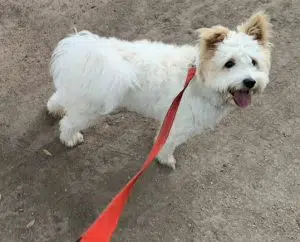
We all know that puppies and of course, many adult dogs, love to chew. While for older dogs destructive chewing is often the result of boredom or anxiety, a teething puppy is likely to relish in finding any soft toy, slipper or pillow laying around to chew on so they can soothe their gums and relieve the pain caused by the growth of their adult teeth.
Just like human babies, puppies are born with no teeth. Their baby teeth, known as milk teeth, 28 in total, grow between 3-4 weeks of age and then at around 4-5 months old will start to fall out in teething puppies to make room for their 42 permanent adult teeth. Just in case you’re wondering, us human adults should have 32 teeth.
The teething puppy process can last anywhere from 8-12 weeks, and can cause them a bit of pain and discomfort in their jaw and gums, which is why they like to chew.
Remember, puppies also chew because it is how they explore and learn about the world around them, so it’s important that we don’t punish them for this and instead provide safe alternatives for them to chew on like the Vitapet soft chicken tenders or lambs ears.
There are also a number of puppy chew toys specifically designed for a teething puppy, some you can fill with their wet food and freeze, as the cold will also provide some comfort to those aching gums. Make sure you look for non-toxic or natural rubber toys or chews. You’ll find more tips on choosing the right toy for your dog HERE.
And of course, remove anything that you don’t want them to chew from their reach because a teething puppy certainly isn’t aware that your pair of expensive shoes are out of bounds if they’ve been left laying enticingly on the ground.
For a home-made alternative grab an old, clean tea towel and soak it in some salt free bone broth, wring it out and twist it tightly before popping it in the freezer overnight. Do make sure you observe them with it though, so they don’t get too excited and chew up the material itself.
If you aren’t sure whether you have a teething puppy, or one that just taking great pleasure in chewing their way around the world around them, there are some signs to look out for in a teething puppy.
This includes:
• red, inflamed gums
• Drooling and unpleasant breath
• Increased chewing – which is the most obvious sign
• Decreased appetite or slower eating
• Missing teeth, which is pretty obvious
• Or increased whining or irritability
While you are likely to notice some blood on their gums or favourite toys during the teething process, if you notice a large amount then do take them to your vet for a check up.
Before all adult teeth have emerged it is a good idea to take them for a dental check up just to make sure there are no serious issues such as cracked or crooked teeth, or jaw misalignment, particularly with short muzzled breeds.
Keeping our puppies bodies and brains moving, regardless of whether they are a teething puppy or not, is really important to help keep boredom at bay.
So don’t forget in between the chew toys to leave them with some interactive toys and puzzles with some tasty treats hidden inside to provide an outlet for them during their early explorative months.
This is important for dogs at all life stages, but never more so than when the risk of having your favourite things chewed up is higher than ever, with that inquisitive mind and mouth ready for action in a teething puppy!
About the Author: Lara Shannon is a certified dog behaviourist and trainer, Executive Producer and Host of Pooches at Play on Channel 10 and editor of Poochesatplay.com. Lara runs her own dog training business in Melbourne’s Bayside area, is a sought after pet expert speaker and Author of Eat, Play, Love (Your Dog).

The role of moisture in dog food



Walking a dog – how much and why

Tips for exercising a dog indoors


Get your paws on Lara Shannon’s best selling books ‘Eat, Play, Love (your dog) and World of Dogs.
Available in Australia, USA, UK and Canada.